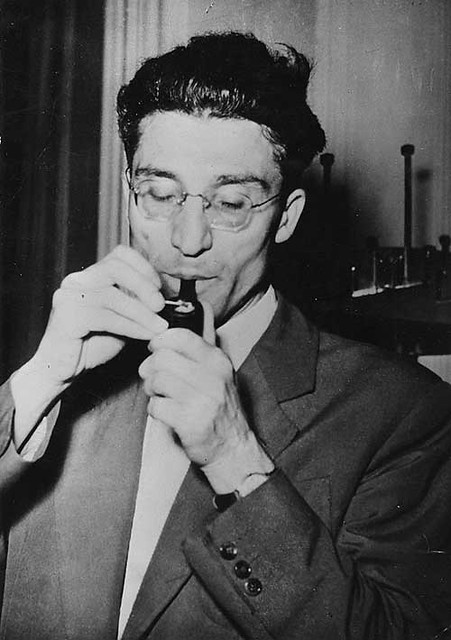1929-1950
Italy, United States
It is well known how Cesare Pavese assumed the role of cultural mediator between the US literary production and the Italian market, primarily through his translations of the contemporary novels (he probably translated also two Mickey Mouse comics in 1933), then as an editor for the publisher Einaudi. His early efforts to establish integration with the transatlantic culture are less acknowledged, but documented for example by the correspondence with a young Italian American, Anthony Chiuminatto (1929-1933), as well as by Pavese's failed attempt to get a position at the Columbia University with the consent of Giuseppe Prezzolini (1930).
After the collapse of the fascist regime, Pavese reduced his works related to the American literature, and the translations of novels (the last one is Faulkner's The Hamlet, Mondadori, 1942) left room to ethnological reflections and studies of the ancient myths. When in 1947 he is working with a famous scholar living in the US, Renato Poggioli, the greatest results of their collaboration come in the field of Slavic literature, rather than American, with the publication of the anthology Il fiore del verso russo (Einaudi, 1949). Nervertheless, a few months before his suicide, the relationship with the actress Constance Dowling entices the writer to new efforts in communicating with the opposite Atlantic shore, resulting in ten poems collected in Verrà la morte e avrà i tuoi occhi (Einaudi, 1951) and in the inscription of the novel La luna e i falò (Einaudi, 1950). Some of Pavese's works thus land in America, sent by the author himself to Dowling's New York address; however, only in the mid-1950s his production achieves a real diffusion in the US.
The literary fame of Pavese's works in America is entirely posthumous. Surprisingly, the United Kingdom anticipates the US interest in his works since the first translation of his masterpiece La luna e i falò (The Moon and the Bonfire, Peter Owen, 1952), acknowledged in America in 1953 (The Moon and the Bonfires, Farrar, Straus and Giroux). While British editions continue to be published, only at the end of the decade the same publisher issues simultaneously Tra donne sole and Il diavolo sulle colline (Among Women Only, The Devil in the Hills, Noonday Press, 1959), both translated by Donald D. Paige. The release inaugurates a period of deeper interest in Pavese's narrative production, which culminates with the arrangement of the Selected Works by Robert W. Flint (Farrar, Straus and Giroux, 1968). Instead, Pavese's work in verse remains unpublished in a separate volume until the release of Lavorare stanca (Hard Labor, Grossman Publishers, 1976), forty years after the first Italian edition (Solaria, 1936) and seven years after the British collection A Mania for Solitude: Selected Poems 1930-1950 (Peter Owen, 1969).
The scarcity of translations and the slow pace of their publishing process certainly prevented a mass reception of Pavese's production. However, they did not hinder its acceptance among the American intellectual class, and especially among scholars of Italian literature, that could read it in the original language. After the pioneering studies of Leslie A. Fielder, who in 1954 provided a first paper for The Kenyon Review, many scholars approached Pavese's production: for instance, Donald Heiney, Giose Rimanelli (whose monograph on the writer was rejected by the publisher), and Gian Paolo Biasin, who dedicated to Pavese the volume The Smile of the Gods: A Thematic Study of Cesare Pavese's Works (Cornell University Press, 1968).
Related Vectors
Renato Poggioli
academic, translator, cultural mediator
Giuseppe Prezzolini
Writer, literary critic, academic, journalist, publisher
Giulio Einaudi editore
publishing house
New Directions in Prose and Poetry
Literary anthology
Lux Film
Production studio
Chelsea
Literary Journal
The Girlfriends
Film
If This Is A Man
book
Sources
Bacchilega, Cristina. "Cesare Pavese and America: The Myth of Translation and the Translation of the Myth." Dispositio 7, n. 19/21 (1982): 77-83.
Biasin, Gian Paolo. The Smile of the Gods: A thematic Study of Cesare Pavese's Works. Ithaca: Cornell University Press, 1968.
Concolino, Cristopher, cur. Cesare Pavese a San Francisco. Atti del Congresso, 24-25 ottobre 2008. Firenze: Franco Cesati Editore, 2011.
Della Terza, Dante. "L'immagine dell'Italia nella cultura americana 1942-1952." Belfagor 37, n. 5 (1982): 513-31.
Fielder, Leslie A. "Introducing Cesare Pavese." The Kenyon Review 16, n. 4 (1954): 536-53.
Frenaye, Frances. "The Traveler Returns." New York Times, May 24, 1953.
Healey, Robin. Italian Literature since 1900 in English Translation: An Annotated Bibliography, 1929-2016. Toronto: University of Toronto Press, 2019.
Heiney, Donald. "American Naturalism and the New Italian Writers." Twentieth Century Literature 3, n. 3 (1957): 135-43.
Heiney, Donald. "Pavese: The Geography of the Moon." Contemporary Literature 9, n. 4 (1968): 522-37.
Mesiano, Rossella. Cesare Pavese di carta e di parole: Bibliografia ragionata e analitica. Alessandria: Edizioni dell'Orso, 2007.
Mignone, Mario, cur. Leucò va in America: Cesare Pavese nel centenario della nascita. An International Conference, Stony Brook, NY, 13-14 marzo 2009. New York: Edisud Salerno/ Forum Italicum Publishing, 2010.
Parisi, Luciano. Italica 90, n. 4 (2013): 684-85.
Pavese Cesare, and Anthony Chiuminatto. Their Correspondence. Toronto: University of Toronto Press, 2007.
Pavese, Cesare, e Renato Poggioli. A meeting of minds: Carteggio (1947-1950). Alessandria: Edizioni dell'Orso, 2010.
Rimanelli, Giose. "Still on Italian Hermeticism." Italica 43, n. 3 (1966): 285-99.
Smith, Lawrence G. Cesare Pavese and America: Life, Love, and Literature. Amherst: University of Massachussetts Press, 2008.


